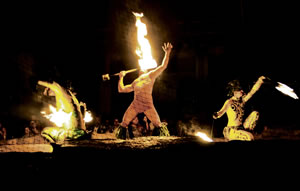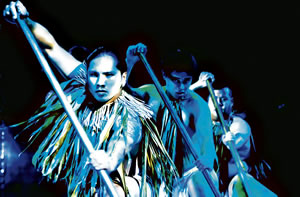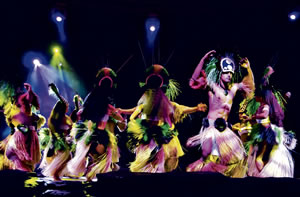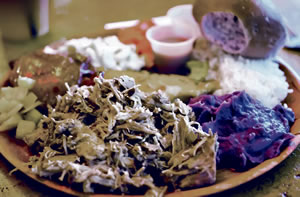Dinner And A Show, Hawaiian Style
“Woot! Woooot!” the whistle blows.“All aboard!” a conductor calls.
An hour before the luau, we board a train powered by a 1939 Whitcomb diesel engine. Inside, mahogany seats and paneling are modeled after the personal car of King Kamehameha.
Our friends Maureen Pierce and Dan Hudson have traveled from Tennessee to get married on Kaua’i. Bill and Carol Leirer, our friends of 18 years, fly from Colorado to witness the wedding. As part of the nuptial celebration, we check out Luau Kalamaku at Kilohana Plantation in Lihu’e.
It’s the night before the wedding, and my husband Dan and I decide to begin the evening with the plantation’s train ride. It winds through the 105-acre working farm, and is an ideal way to introduce our guests to Kaua’i’s plant and wildlife.
Bill is excited to learn that papayas are good for digestion, and that bananas are an herb rather than fruit. Maureen, who spent many vacations on Kaua’i with her late father, laughs at the conductor’s jokes and quietly takes pictures through the wide window. A rainbow arcs across the garden, and her fiancé Dan snaps a few shots over her shoulder.
We stop to feed goats, sheep and wild boar that are in a pen. The conductor assures us that domestic Berkshire pigs are used at the luau, and the boars are pets. They run for bits of bread, and the goats, with their hooves pressed against the fence, stretch their necks out for a nibble. Little ones laugh and reach for more food. Carol breaks into a childlike chuckle.Disembarking the train, we walk to the tent-like auditorium that seats up to 1,400 people. Because of the weather, retractable walls have been let down. Nine hundred people sita at tables enclosing a round stage in the center. In three back corners, there is an open bar and a well-stocked buffet. Kukui nut lei are offered to the women, shell lei for the men and programs for all.
A conch shell sounds. Four men dressed in kapa cloth carry a pig fresh from the imu. A mele pule starts the luau, and as the prayer is sung, servers bring plates of fresh pineapple, Hawaiian sea salt, taro buns, soft butter and a green salad.
Live music plays as ladies in ti leaf skirts dance and sing. Along the buffet, trays of traditional and contemporary luau food are laid out: Kalua pork, sweet poi, pan-fried ono, vegetarian Thai coconut curry and teriyaki chicken thighs. Side dishes included silky coconut and purple sweet potato puree, lomi lomi salmon, tofu and tomatoes with limu (seaweed), steamed rice, and a tasty mac salad made with crisp onions, celery and peas.
For dessert we indulge in rice pudding with rum sauce, a rich and chocolaty cheesecake made with Kaua’i Coffee, moist pineapple upside-down cake, and banana cream pie with a coconut graham cracker crust.
Suddenly, plates are cleared, the bar closes up and the show begins.
On the dark stage, a female chant circles the room, a male chant echoes behind. A Tahitian drum beats ominously. In the spotlight, the chief, wearing a haku head lei and dressed in a floor-length cape, holds a kalamaku (flaming torch). He prays to Akua and asks for guidance. A journey is decided upon.Colorful lights dance as he sings to his daughter Orama. He is leaving, and will send for her when the time is right. They argue. Behind us, and from three corners, a line of four dancers walks to the stage. Each person holds a kalamaku. A pulsating Tahitian dance is performed while the daughter prays to her ‘aumakua, pleading for the men to stay.
A festive ukulele inspires a seductive dance, and sends the men off in high spirits. Orama says goodbye to her love Ari. “Auwe!” she wails. The Spirit of the Sea, flowing with gauzy white wings, reveals a vision to Orama. She will have Ari’s child.
Seven burly men briskly dance the voyage with canoe paddles. Using the stars and currents as their guide, they argue the correct course. A storm hits.
The Blue Wind circles the exhausted men with wispy azure wings. The Spirit of the Sea mixes elements with the Blue Wind and the voyage gains strength.
The music is loud, lyrical, angelic and provocative. It reminds me of Disney, and I wonder if it’s really live. Bill, who is a musician, wonders the same thing and darts towards the band. We don’t see him until the end of the show.
Landing on Kaua’i dressed in head and neck, wrist and ankle lei, the voyagers dance in celebration. Taro is planted; clothes are made. Boys spear fish and wrestle. The chief sings a lonely song and sends for his daughter. Sharp calls from behind make me whip my head around and I see Orama lamenting, alone.Fire rises from the center of the stage. Pele, the Goddess of Fire, whips flaming poi balls into the air. Her lover Lohiau, sister Hiiaka, and the Mo’o (Dragon Women of Haena) join her. Ari sends fire-knives around his body in a fantastic frenzy. Staccato drums accelerate; colorful lights flash. Yearning, Orama sings from behind.
Two men at her side paddle earnestly and bring her to a new home. After a wedding celebration, a child named Kalamaku is born. The flamed torch lives on in a new land. A wave of applause and cheer fills the room.
“That was fantastic!” Bill shouts over the accolades. “The majority of people who come here will think that the music is canned. But there’s live music that rocks! I walked over there and every bit of it was live. They were awesome!”
“It’s a cultural journey for all ages,” adds Carol, “that everyone who visits the island should experience.”
“I found myself completely enthralled,” Dan Husdon says. “The choreography was stunning. The intensity and sincerity of the actors really blew me away.”
There’s a catch in his throat, and he pauses to collect his thoughts.
“It was a natural expression for them,” he continues. “They weren’t playing characters so much as they were embodying their ancestors.”
“The bodysuits, beautiful masks, makeup, artistry and dancing – it was beautiful,” says Maureen. “There were no acrobatics, but it was like a Hawaiian Cirque du Soleil.”
Kalamaku Luau $121.87 for train ride and luau; 245-9593 mlane@midweekkauai.com







